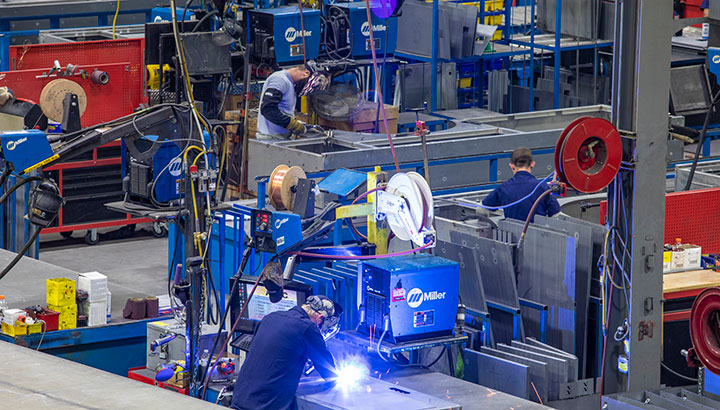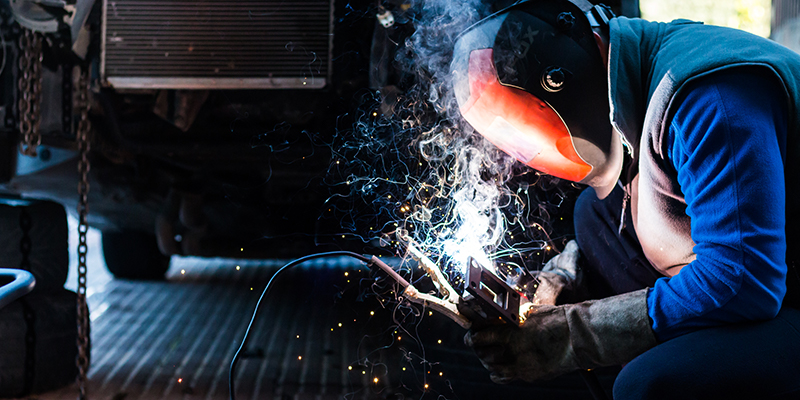All Regarding Welding: Key Insights Into Techniques and Finest Practices for Success
Welding encompasses a range of techniques, each matched for details products and applications. Recognizing these methods, such as GMAW, SMAW, and TIG, is crucial for accomplishing suitable outcomes. In addition, the best tools and security practices can not be overlooked. As preparation and fixing play vital roles in the welding procedure, understanding these elements can greatly boost the high quality of the last product. What are the vital factors that guarantee an effective weld?
Understanding Different Welding Methods
Welding techniques include a selection of methods, each suited to particular applications and materials. Amongst the most common strategies are Gas Metal Arc Welding (GMAW), Shielded Steel Arc Welding (SMAW), and Tungsten Inert Gas Welding (TIG) GMAW, also called MIG welding, is prominent for its speed and adaptability, making it suitable for slim materials. SMAW, or stick welding, is favored for its simpleness and effectiveness in outdoor settings, particularly with thicker steels. TIG welding supplies accuracy and control, making it appropriate for detailed work and non-ferrous steels (Welding). Each strategy has its unique benefits and considerations, allowing welders to pick the finest approach based upon the job's needs, material type, and preferred results. Recognizing these strategies is crucial for effective welding
Vital Welding Tools and Devices
While numerous welding techniques require specific skills, the appropriate tools and devices are just as vital for attaining top quality results. Important welding devices includes welding machines, which differ depending upon the technique-- such as MIG, TIG, or stick welding. Safety gear, consisting of helmets, aprons, and handwear covers, guarantees safety and comfort throughout the procedure. Furthermore, clamps and fixtures assist safeguard materials in location, guaranteeing precision in welds. Consumables like welding rods, wire, and securing gas are additionally critical parts that affect the top quality of the weld. Furthermore, devices such as cutters and mills assist in surface area preparation and post-weld finishing, adding to a professional result. Investing in high-grade equipment inevitably boosts the performance and effectiveness of welding jobs.
Safety Practices in Welding
Appropriate security methods are crucial in the welding industry to secure workers from prospective risks. Welders must use suitable individual safety tools (PPE), including helmets with proper shading, gloves, and flame-resistant apparel. Ample ventilation is crucial to lower exposure to hazardous fumes and gases generated throughout the welding process. In addition, workers should be learnt the proper handling of welding equipment to avoid crashes. Fire security measures, such as keeping combustible materials far from the welding location and having fire extinguishers readily available, are essential. Routine evaluations of devices and work areas can assist recognize potential hazards prior to they bring about crashes. By adhering to these safety and security techniques, welders can create a safer working environment and reduce risks linked with their profession.
Readying Materials for Welding
Preparing products for welding is an essential action that considerably influences the top quality and stability of the final product (Montana Mobile Welding and Repair Welding). Correct preparation includes cleaning up the surface areas to get rid of impurities such as oil, corrosion, and dust, which can compromise the weld. Methods such as grinding, sanding, or utilizing solvents are typically employed to accomplish a tidy surface area. Additionally, guaranteeing that the products mesh well is necessary; spaces can cause weak welds. It's likewise essential to take right into account the placement and positioning of the parts, as this will impact the convenience of welding and the final outcome. Selecting the suitable filler product and ensuring compatibility with the base metals is essential for achieving strong, sturdy welds.
Tips for Achieving High-Quality Welds
Achieving premium welds needs attention to detail and adherence to best techniques throughout the welding procedure. Proper joint preparation is necessary, making sure surface areas are clean and totally free from pollutants. Choosing the proper filler product and welding technique based upon the base metals is essential for suitable bonding. Keeping consistent travel rate and angle while welding can stop problems and advertise harmony. Furthermore, regulating heat input is essential; excessive warm can cause bending and weakened joints. Consistently examining the welds throughout the procedure permits instant modifications if required. Using ideal post-weld treatments, such as cleansing and stress alleviation, can enhance the durability and integrity of the weld, eventually making sure a successful result.
Fixing Typical Welding Issues
Welding commonly provides obstacles that can influence the high quality and stability of the last item. Usual issues such as porosity, irregular weld grains, and getting too hot can occur, each calling for particular troubleshooting strategies. Comprehending these problems is essential for welders to boost their skills and achieve optimal results.
Porosity Problems Described
Porosity can commonly be overlooked, it remains an important problem in welding that can compromise the stability of a finished product. Porosity describes the visibility of small gas pockets within the weld bead, which can damage the joint and lead to early failure. This problem usually arises from impurities, moisture, or improper securing gas coverage during the welding process. To reduce porosity, welders need to validate that the base materials are dry and clean, utilize proper securing gases, and preserve constant welding specifications. Regularly inspecting the equipment and atmosphere can also assist recognize prospective problems before they show up in more tips here the weld. Dealing with porosity efficiently is important for achieving solid, sturdy welds that meet quality standards.

Inconsistent Weld Beans
Inconsistent weld beads can substantially impact the top quality and toughness of a finished product. Different factors add to this problem, including incorrect travel rate, inaccurate amperage settings, and inconsistent electrode angles. When the welder moves as well quickly, a grain might show up slim and do not have penetration, while moving also slowly can cause excessive build-up. Additionally, making use of the incorrect amperage can lead to either damaging or too much spatter, both of which compromise weld stability. The welder's technique, such as irregular lantern activity, can also bring about unequal bead look. To mitigate these problems, welders need to concentrate on preserving stable, controlled motions and guaranteeing appropriate devices setups to accomplish uniformity in their welds. Consistency is crucial to accomplishing reliable and solid welds.
Overheating and Bending Issues
Too much warm throughout the welding procedure can cause substantial getting too hot and buckling problems, influencing the structural integrity of the work surface. These troubles commonly materialize as distortion, which can endanger placement and fit-up, making further assembly testing. Aspects adding to overheating consist of the selection of welding specifications, such as voltage and take a trip rate, along with the kind of product being welded. To mitigate these concerns, welders need to keep regular travel speed and appropriate warmth input while monitoring the work surface temperature level. Furthermore, preheating or post-weld warmth therapy can aid from this source reduce tensions triggered by rapid air conditioning - Belgrade Fabrication. Routine examination and adherence to ideal practices are vital in protecting against getting too hot and making certain the durability and integrity of welded structures
Often Asked Questions
What Are the Profession Opportunities in the Welding Sector?
The welding market supplies varied career chances, consisting of placements as welders, teachers, engineers, and assessors. Experts can operate in manufacturing, construction, aerospace, and vehicle sectors, taking advantage of solid need and competitive salaries in numerous functions.
Just How Can I Boost My Welding Speed Without Giving Up Top Quality?
To boost welding speed without sacrificing quality, one ought to exercise reliable strategies, maintain equipment, optimize settings, and boost hand-eye sychronisation. Regular training and seeking comments can likewise considerably add to accomplishing much faster, high-quality welds.
What Qualifications Are Available for Welders?
Many certifications exist for welders, including those from the American Welding Culture (AWS), the National Center for Construction Education And Learning and Research Study (NCCER), and numerous industry-specific organizations. These qualifications enhance employability and show skill efficiency.
Exactly How Does Welding Influence the Residences of Metals?
Welding affects the homes of steels by modifying their microstructure, which can result in modifications in solidity, ductility, and stamina. Heat input and cooling rates throughout the procedure substantially influence these material characteristics.
Can I Weld Dissimilar Metals Together?
